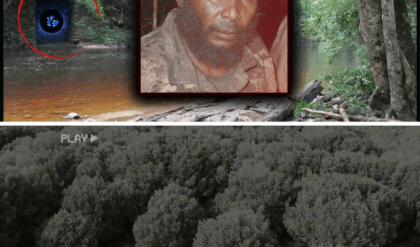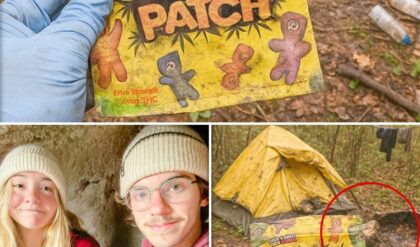On January 12, 1996, the temperature in Canora, Ontario, dropped to -25°C (-13°F). Vast stretches of boreal forest surrounded the town, stretching for thousands of kilometers, dotted with lakes, swamps, and towering spruce and pine trees. In the biting cold, Richard Norman – a 32-year-old experienced logger – began his day with his eight-person crew at a logging site near Red Lake, about 40 kilometers north of Canora.
Richard was a reliable, hardworking man, a devoted family man with a wife and two children. His colleagues respected him for his diligence, his quiet efficiency, and his calm, no-nonsense attitude. He had spent over a decade navigating the forests of Ontario and knew how to handle the harsh winter conditions. For him, the forest was a place of familiarity and control, a place where experience mattered as much as strength.
That afternoon, as darkness began creeping over the treeline, a problem arose: a cable used to transport logs had become stuck about 200 meters from the main work area. Without hesitation, Richard volunteered to check it. He took his axe, flashlight, and walkie-talkie, layered a thick jacket over his flannel shirt, pulled on his hat, and assured the crew he would return in twenty minutes.
Half an hour passed. Then an hour. Richard did not respond to the walkie-talkie. At first, the crew assumed interference, but concern grew rapidly. Three men decided to follow his tracks in the fresh snow. At first, the footprints led in a straight line toward the cable. Then, strangely, they began to zigzag.
One of the workers, David Hall, later recalled that it looked as though Richard had turned abruptly and began running. The footprints grew deeper and wider, indicating that he was moving fast. But there were no other tracks – no animal tracks, no other human tracks, nothing but Richard’s.
After about 100 meters, the footprints suddenly stopped. They vanished entirely in the middle of a flat snowfield. The surrounding snow was pristine, undisturbed. There were no signs of a struggle, no dragged marks, nothing. It was as if Richard Norman had simply vanished into thin air.
By that time, darkness had fallen completely, and a snowstorm began to blow in. The men returned to base, radioed the main office in Canora, and an alarm was raised. The following morning, a search party arrived from Canora, consisting of police, volunteers, and a Department of Natural Resources gamekeeper – twelve people in total.
The blizzard worsened overnight, temperatures dropped to -30°C (-22°F), and visibility fell to just a few meters. The search progressed slowly. The group followed the exact path Richard had taken, but the same phenomenon occurred: his tracks disappeared into nothingness.
The morning of January 14th dawned clear but bitterly cold, with temperatures around -28°C (-18°F). The blizzard that had hampered the search the day before had subsided, and a helicopter from Canora was dispatched to assist in locating Richard. The pilot scanned the vast, snow-covered expanse for any sign of him: bright clothing, footprints, or a campfire.
Around 11 a.m., the pilot noticed something unusual in the distance: bright fragments of fabric caught high in a spruce tree, roughly 300 meters from where Richard’s tracks had vanished. The helicopter landed nearby, and the search party approached cautiously.
At a height of about three meters, pieces of a flannel shirt and part of a jacket were hanging from the branches. The fabric was torn into large, jagged fragments, immediately recognizable as Richard’s by their distinctive check pattern and brand. But there was no body beneath the tree. No blood, no footprints, no other clothing. Just his torn garments suspended in the air.
One police officer climbed the tree to retrieve the fabric. Examining the tears, he noted something chilling: they were not along the seams, and they bore no resemblance to claw marks from local wildlife. Wolves and bears typically leave parallel scratches and bite marks; these rips were jagged, irregular, as if the fabric had been violently pulled apart with immense force.
The surrounding snow showed only minimal disturbance, not enough to suggest a struggle, dragging, or fall. The tree itself bore no scratches or claw marks that might indicate an animal had climbed it. It was ordinary in every visible way, yet the scene defied explanation.
The central question haunted everyone present: how had the clothes ended up three meters above the ground? If Richard had climbed the tree himself, there should have been scratch marks on the bark, imprints in the snow, or signs of struggle. If an animal had hoisted him, what kind of creature could lift a grown man three meters without leaving any trace? And most importantly, where was his body?
The search expanded for several days, covering a square kilometer radius around the tree. Teams combed through frozen streams, ravines, and windfallen debris. They shouted, flashed lights, and fired warning shots – standard signals for a missing person. Yet there was nothing. Richard Norman had vanished, leaving only torn clothing as the only clue.
The pieces of fabric were sent to the Canora police department for further examination. A local forensic consultant, experienced in animal attack cases, concluded that the damage could not be explained by any known predator in the region. Bears tear with claws and teeth, wolves bite and drag – but none leave rips like those found on Richard’s clothing. The nature of the fabric damage, combined with the total disappearance of the man himself, only deepened the mystery.
No explanation fit. There were no traces, no signs of wildlife interference, no human footprints nearby. Richard Norman had walked into the forest and simply ceased to exist, leaving behind one of the most perplexing mysteries in Canora’s history.
The discovery of Richard’s torn clothes left investigators puzzled. How could a grown man vanish in the middle of a snowfield, leaving only fragments of his clothing three meters above the ground? The scene offered no explanation, no signs of struggle, and no physical evidence pointing to an animal attack. Local police expanded the search and brought in experts to examine every possible scenario.
Interviews with Richard’s coworkers confirmed what everyone already knew: he was experienced, cautious, and physically capable. He had over ten years of logging experience, knew the forest terrain intimately, and understood the dangers of winter work. There was nothing reckless in his behavior that day. The thought that he had wandered off blindly or fallen into a hidden crevice seemed implausible.
The police consulted with wildlife experts. Wolves and lynxes were active in the region, though bears hibernated during January. Yet, none of these animals could account for the torn clothing. Predator attacks leave characteristic claw or bite marks, or at least traces on the tree trunk or in the snow. None of these indicators were present. It was as if some unknown force had lifted the clothes and left the forest completely undisturbed.
Psychologists and forensic consultants were called in to speculate on human involvement. Could Richard have been abducted? But the area was remote, isolated, with only the logging crew nearby. No footprints suggested another human presence. No vehicle tracks, no disturbed snow, nothing. It was a geographic and logistical impossibility for a person to remove him unnoticed, especially in a snowstorm with multiple workers nearby.
Witness accounts added further layers to the mystery. David Hall, one of the coworkers who had followed Richard’s tracks, described the footprints abruptly widening and deepening as if he were running, then stopping suddenly. Hall recalled a sense of urgency in the path, as though Richard had sensed a threat. Yet there was no indication of what could have caused such fear. The snow around the termination point was perfectly smooth, as though a vanishing act had occurred.
Local lore and stories of the Canadian wilderness began circulating among the searchers. Some old-timers spoke of “the spirits of the boreal forest,” supernatural forces that occasionally claimed the lives of loggers and travelers. Others speculated about strange magnetic anomalies or rare weather phenomena, capable of disorienting or lifting objects. While authorities dismissed most of these as folklore, the lack of a rational explanation left an uneasy openness to any theory.
Investigators examined similar cases. A few isolated incidents across Canada involved sudden disappearances in winter forests, often with small items found in inexplicable locations. Torn clothing suspended in trees, tracks that disappeared mid-stride, and missing persons who were never recovered. Yet no pattern was conclusive. Each case was unique, yet Richard’s stood out because of the combination of his expertise, the physical impossibility of the clothing’s placement, and the utter lack of a body.
For weeks, the search continued in a progressively wider radius. Helicopters scoured the snow-covered landscape, ground crews followed potential leads, and divers explored frozen lakes in the area. Nothing was found. Richard Norman had left no trace – a fact that haunted everyone involved. The forest, with its serene beauty and deadly cold, had swallowed a man without leaving the simplest of clues.
Theories proliferated. Some considered highly improbable scientific anomalies: sudden sinkholes hidden beneath snow, micro avalanches, or rare phenomena that could displace matter vertically. Others leaned toward darker possibilities: unknown predators, or even human perpetrators with expertise in handling extreme environments. Yet all remained speculative, unsupported by physical evidence.
The case became a permanent enigma. Local authorities filed it as an unresolved missing person investigation, but word spread beyond Canora. The combination of remote wilderness, extreme cold, torn clothing inexplicably suspended in a tree, and the complete disappearance of the body made Richard Norman’s case a unique and enduring mystery. It was a reminder of the Canadian wilderness’s unforgiving nature, a place where the ordinary rules of life and death seemed to bend.
Despite weeks of searching, Richard Norman’s body was never found. The torn clothing suspended in the spruce tree remained the only tangible clue. Police eventually scaled back active searches, though local authorities and residents never stopped discussing the case. Every winter, the forests surrounding Canora seemed to whisper the mystery, a silent reminder of a man who had simply vanished.
Experts continued to debate. Wildlife specialists maintained that no known predator could have caused the clothing to hang three meters high without leaving claw marks or other evidence. Loggers and survivalists, people who knew the forest intimately, shook their heads in disbelief. The abrupt disappearance of the footprints, the zigzagging pattern in the snow, and the complete lack of a body defied logic. Every explanation – animal attack, abduction, accident – fell short.
For the people of Canora, the case became more than a missing person story; it became a legend of the northern forests. Elders recalled other tales of sudden vanishings and strange phenomena, passed down from trappers and hunters, reinforcing the sense that the boreal wilderness held secrets beyond human comprehension. Parents warned their children to respect the forest’s power, and loggers spoke of Richard Norman’s fate in hushed tones, a cautionary tale of a place that could swallow even the most experienced.
Some investigators speculated on paranormal or unknown natural phenomena. Could a rare meteorological event lift objects vertically? Could magnetic anomalies disorient and displace a human being? While most scientists dismissed such ideas, the sheer impossibility of the known explanations left a lingering sense of uncertainty. The torn clothing and the missing body refused to yield their secrets.
Richard’s family was left with unanswered questions, grappling with the void his disappearance created. His wife and children endured the agony of not knowing, their grief compounded by the inexplicable nature of the case. His colleagues remembered his skill, his calm demeanor, and his respect for the forest, mourning not only his loss but the unsettling realization that the world could sometimes behave in ways beyond comprehension.
Over time, the story of Richard Norman entered the annals of Canadian mystery folklore. Books, local news reports, and podcasts chronicled the case, emphasizing the impossibility of the known facts. How could a man’s tracks vanish into the snow? How could torn clothing appear hanging in a tree with no signs of animal or human interference? And most haunting of all: where was Richard Norman?
Even decades later, the case remains unsolved. The boreal forests around Canora, Ontario, stand silent, cold, and imposing. They serve as a testament to the power of nature, a reminder that even experienced humans are vulnerable, and that some mysteries resist explanation. Richard Norman’s disappearance challenges our understanding of reality, a chilling reminder that the wilderness can hold secrets that defy logic, science, and human comprehension.
To this day, hikers, hunters, and loggers traveling through the area recount the story of Richard Norman, wary of the forest and mindful of its unpredictable power. The torn fabric in the tree, though long gone, lives on in the collective memory of the region as a symbol of an unresolved, inexplicable event – one that continues to fascinate, terrify, and puzzle all who hear it.
Richard Norman’s story is more than a missing person case; it is a cautionary tale, a blend of natural beauty, extreme conditions, and the haunting unknown. It reminds us that even in the familiar, in a place one thinks one knows, the world can behave in ways we cannot predict, leaving questions that may never be answered.





